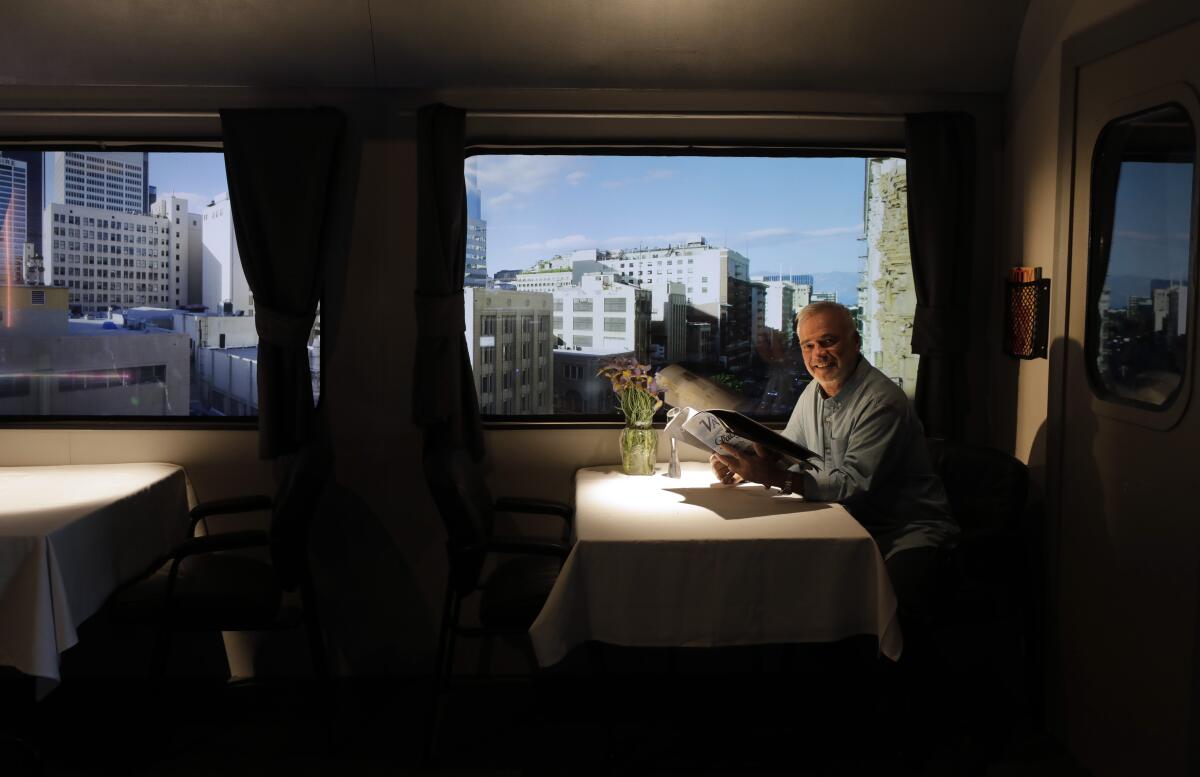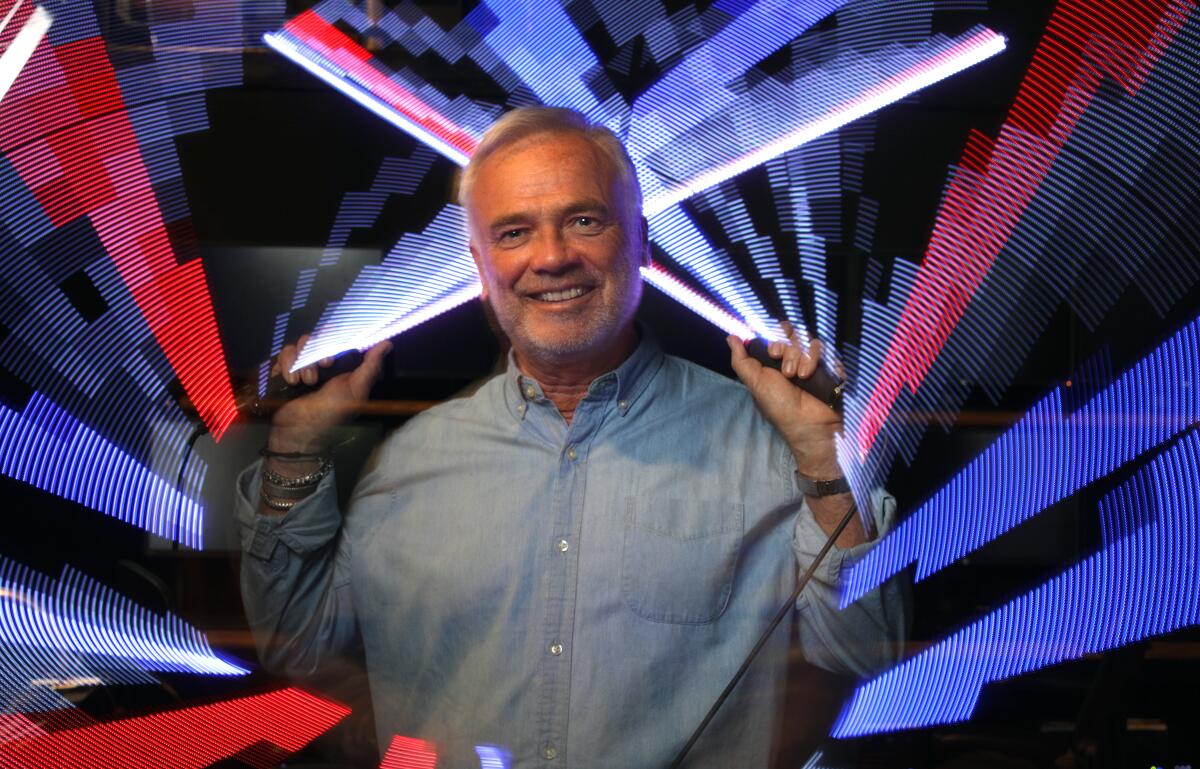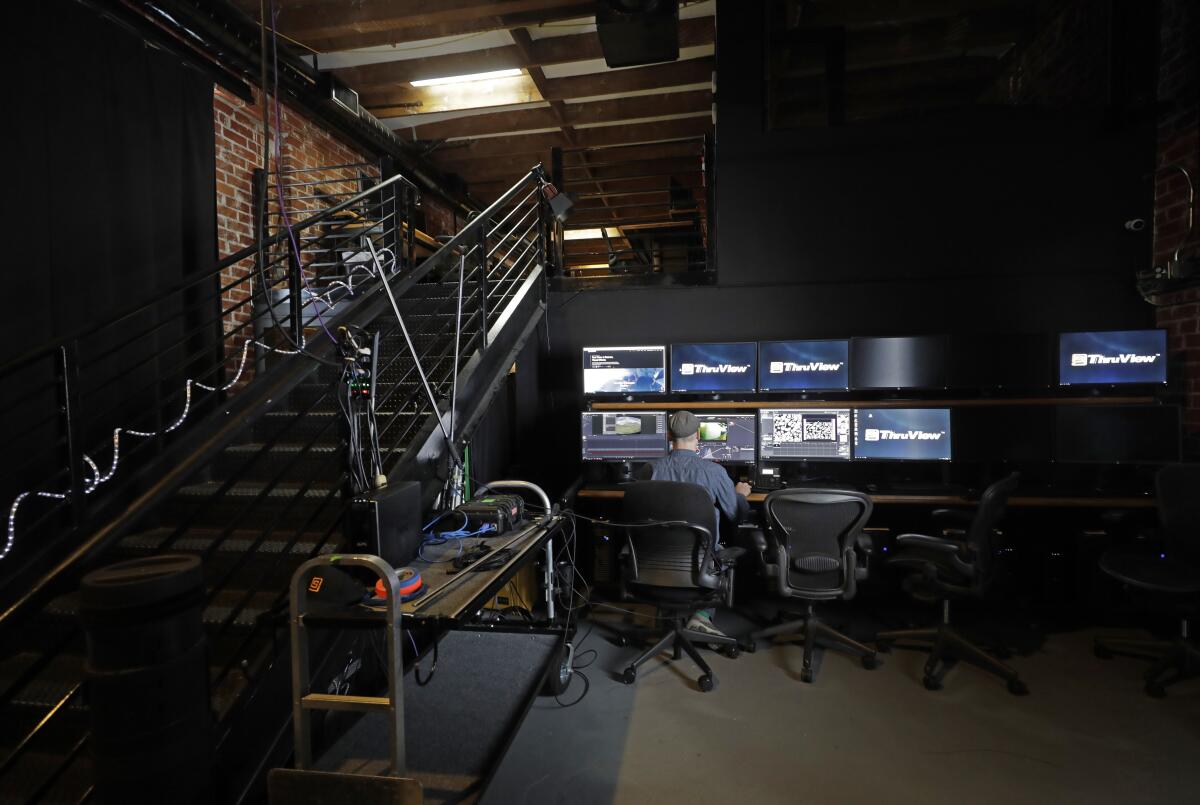Virtual filmmaking takes center stage in reopening Hollywood

- Share via
When “Good Trouble” returns to screens, fans of the Freeform TV drama will reconnect with the two young women, Callie and Mariana, trying to make it in Los Angeles.
But instead of shooting scenes in downtown L.A. — an impossibility during the shutdown caused by the COVID-19 pandemic — filmmakers are digitally recreating the historic Palace Theatre and other landmarks on a set in Valencia.
By fusing the latest advances from the video game world, using software that powers the hit game “Fortnite,” producers will shift much on-location shooting indoors to Santa Clarita Studios, projecting photo-real imagery of downtown’s skyline on LED video walls.
“We are preparing all the virtual assets so that on Day One they can be as if they were shooting exterior L.A. but they will be on a set with limited people in Valencia,” said Sam Nicholson, chief executive of Pasadena-based Stargate Studios, which has partnered with the creators to create the virtual sets.
As Hollywood faces mounting pressure to resume production and reemploy hundreds of thousands of cast and crew who’ve been out of work for months, filmmakers are turning to virtual producers like Nicholson as a route to reboot TV shows and features halted by the pandemic. Some predict the health crisis will accelerate the industry’s use of virtual filming to mitigate risks and reduces costs of on location shoots.
“It’s the tip of the iceberg,” Nicholson said. “People have to utilize these tools to get back on line. Once they’ve utilized them and realized its faster, better, cheaper, you will see a lot more virtual production coming down the pipeline.”
Marco Fargnoli, director of photography for “Good Trouble,” said virtual production will provide a safe alternative to cast and crew as they return to work.
“Once everybody agrees on the protocols that will allow us to get back to work, we just want to be able to maintain the creative freedom that we had before the shutdown, as much as possible,” Fargnoli said. “Not have scenes with only two people in a kitchen talking. ... We want to be as unhindered and unencumbered as possible and still be safe.”
Producers expect that in coming weeks studios and producers will need to comply with new protocols, including frequent testing and handwashing, to prevent the spread of the coronavirus. Virtual production, they say, is one way to mitigate the risks.
“Once you take the machinery of that show and bring it out to successive locations, you are exponentially increasing your risk factor,” said Fargnoli.
The 66-year old Nicholson, a visual effects supervisor and cinematographer, said his company is fielding calls from streaming companies and studios eager to revive films and TV shows as fast as possible.
“We are bidding six jobs right now that are considering dropping set building and their location work, and using virtual sets,” Nicholson said via Zoom from his Pasadena home. He said Stargate also is preparing to work on a new season of Fox’s medical drama “The Resident,” possibly this summer.

Virtual production isn’t new. But thanks to the video gaming world, the technology has advanced well beyond the use of green screens, where actors perform in front of a blank screen that is green or blue and later replaced by an alternate background.
Instead of performing against a static, blank screen, actors and crew can interact in real time within a 3-D environment projected onto LED screens.
Walt Disney’s hit show “The Mandalorian,” about an intergalactic bounty hunter, is a recent example of the possibilities of virtual technology.
Director Jon Favreau collaborated with Industrial Light & Magic, the special effects studio made famous for its work on “Star Wars,” and Epic Games and other technology companies, to create a 20-foot-high, 270-degree semicircular LED video wall that eliminated the need for location shoots entirely.
On a Manhattan Beach stage, the filmmakers could recreate the dusty ochre tinged backdrop of a Tunisia-like world.
“To a lot of folks, virtual production can often sound like we are making ‘Avatar,’” said Richard Bluff, visual effects supervisor for “The Mandalorian,” speaking on a video panel for the National Assn. of Broadcasters earlier this month.
About half of “The Mandalorian’s” first season was shot against LED screens, Bluff said.
Sets can be lighted and cameras track action as if in that environment, playing it back for the director in real time, as opposed to having to wait for months after the shoot has wrapped to see the results typically created by visual effects artists after the fact. Backgrounds can be swapped out easily, avoiding costly set construction, Bluff said.
“Our show doesn’t have the scale to be able to go to Tunisia and shoot our TV show, so we sent artists to go photograph various locations and bring the location to the stage,” Bluff said.
But the technology isn’t just being used to create fantasy worlds.
Nicholson, who cut his teeth on the first “Star Trek” movie, highlighted the example of this year’s HBO show “Run,” a drama set largely on a train. Stargate used its virtual system to create the views out of the windows of the train to give the impression that it was speeding along. The screens can also be operated remotely, reducing the number of crew on set, Nicholson said.
Nicholson started his studio in 1989. When 9/11 shuttered production on the popular show “ER,” Stargate jumped into action tracking across Chicago to capture 25 different locations and recreating the locations virtually so the actors could film against a backdrop rather than go out into the city.
Today, Stargate generates over $26 million globally annual revenue and employs more than 150 digital artists, producers and technicians. The company has studios in Toronto and Vancouver, Canada; Bogota, Colombia, and Beijing, allowing it to benefit from any tax incentives in those regions, but much of its work is handled out of Los Angeles. Globally, sales grew by double digits last year, Nicholson said. He declined to disclose earnings but said the company is profitable.

Stargate’s growth has been fueled in part by rapid advances in technology borrowed from the gaming industry.
Its proprietary system uses a free software known as Unreal Engine, produced by Epic Games.
Miles Perkins, who works in business development for Epic Games, said the Unreal Engine is being embraced by the film community in a way it hasn’t in the past and interest is “extremely high,” he said. A rival software known as Unity was used by Favreau to create a supposedly live-action “Lion King,” which included only one non-CGI shot.
“I’ve been in this business for a long time, since beginning of the ‘90s,” Perkins said. “For the first time I’m having significant meaningful conversations with [studios] heads of physical production.”
Virtual technology recently allowed the filmmakers for the Warner Bros.’ science-fiction movie “Reminiscence” due out next year to complete the post-production work through video calls rather than in screening rooms in L.A., said the movie’s VFX supervisor Bruce Jones.
Jones, who has been able to work remotely from Montana, said the new methods give an insight into how Hollywood may work in the future. Instead of traveling to a far-off location, which involves crews coming together from around the world, visual effects artists can spend months at the beginning of production to recreate those scenes for an actor to step into, Jones said.
“One day you’re shooting a desert scene and the next day you’re shooting a scene in the Arctic and all you ended up doing was some costume changes, but it’s still that same controlled environment that you are going to,” Jones said.
More to Read
Inside the business of entertainment
The Wide Shot brings you news, analysis and insights on everything from streaming wars to production — and what it all means for the future.
You may occasionally receive promotional content from the Los Angeles Times.











